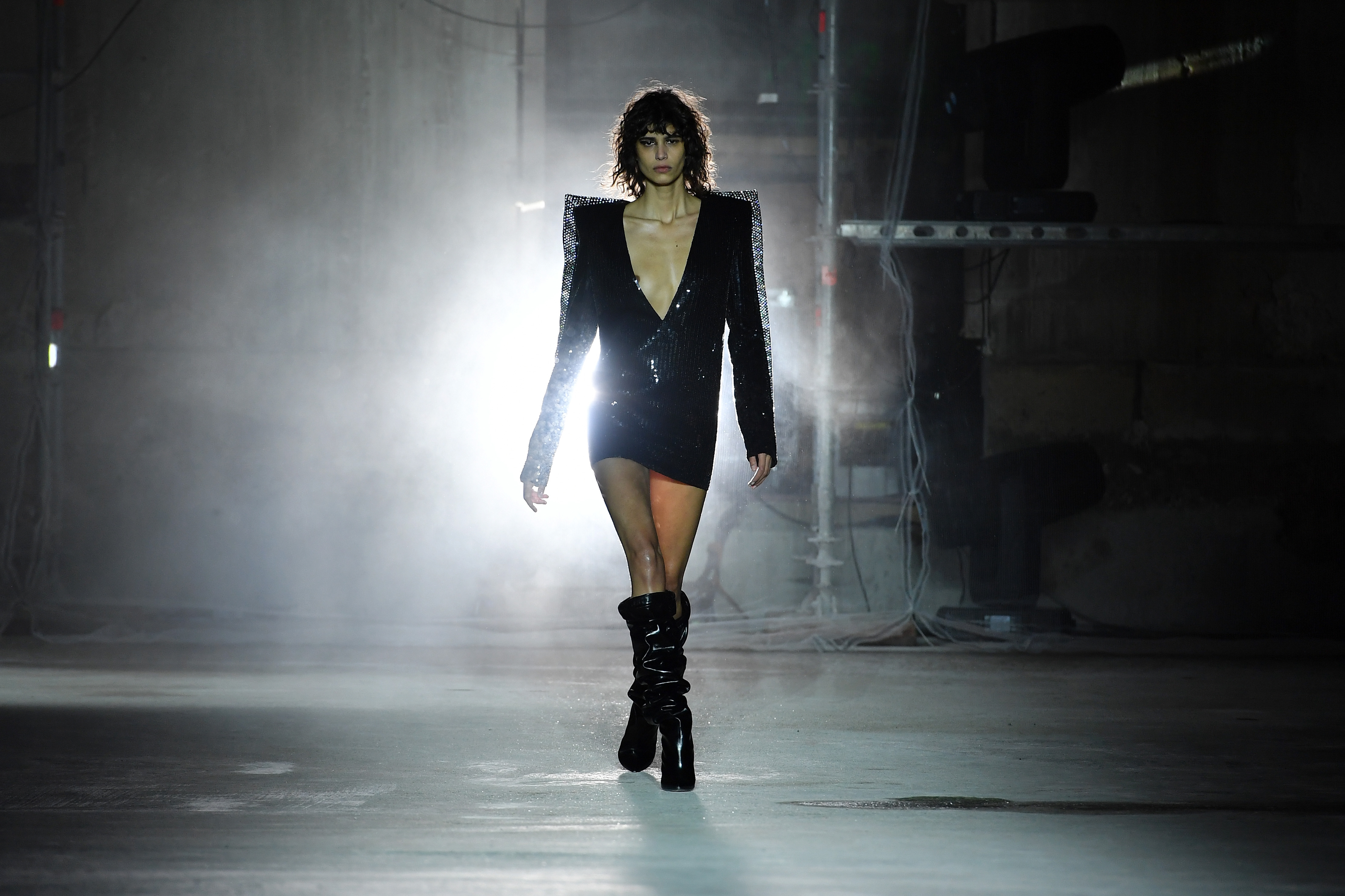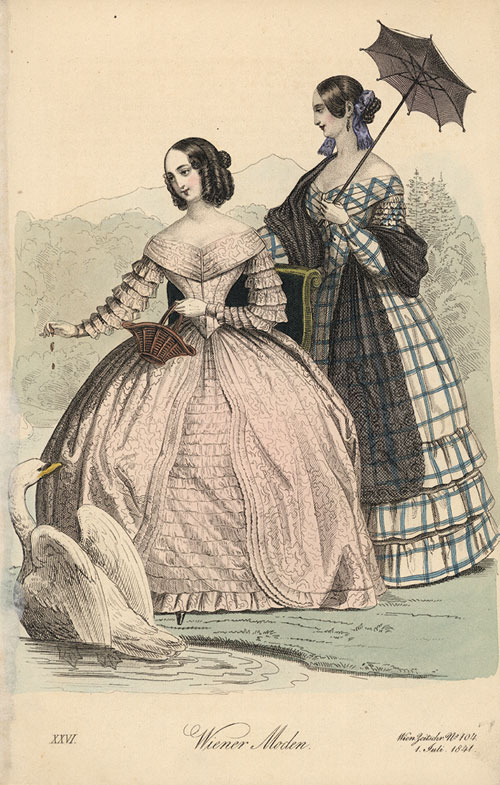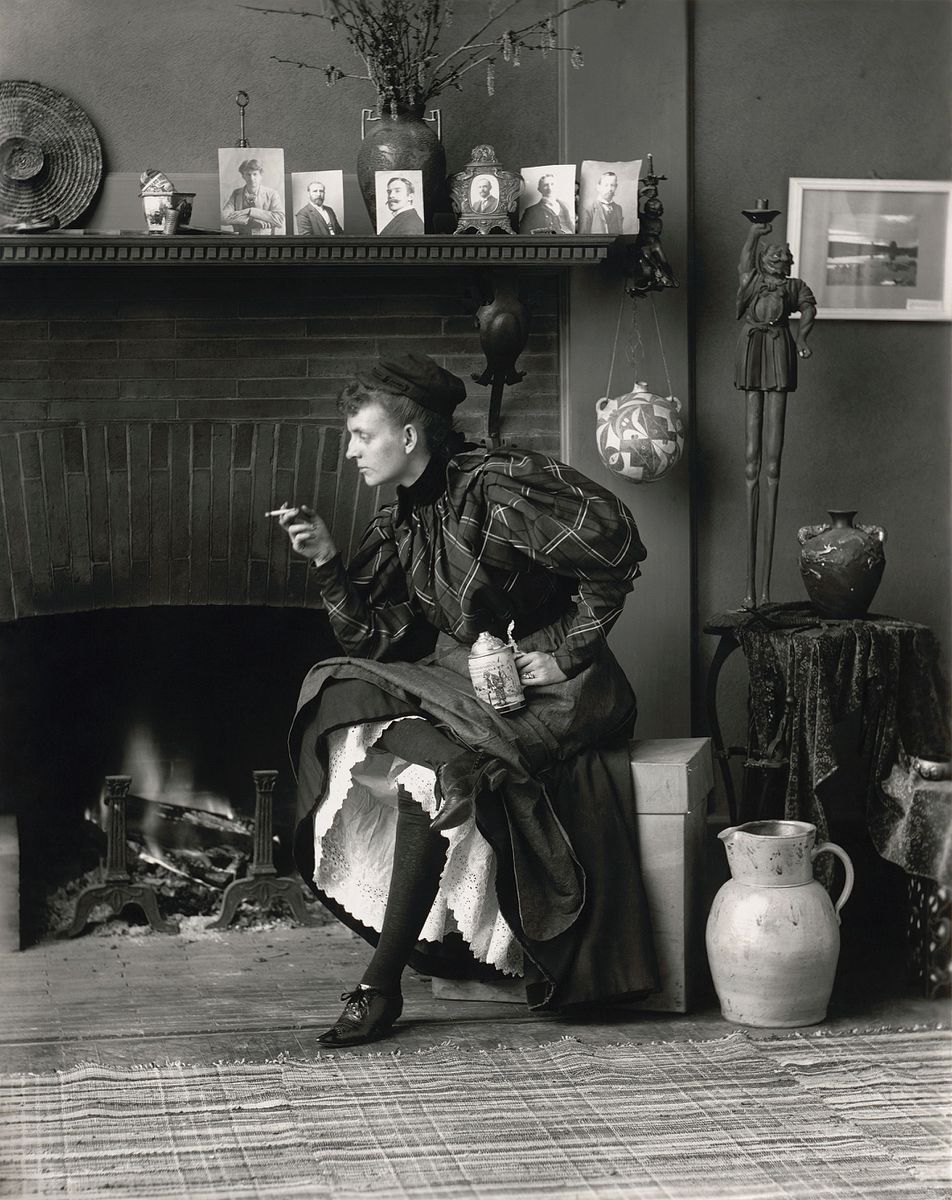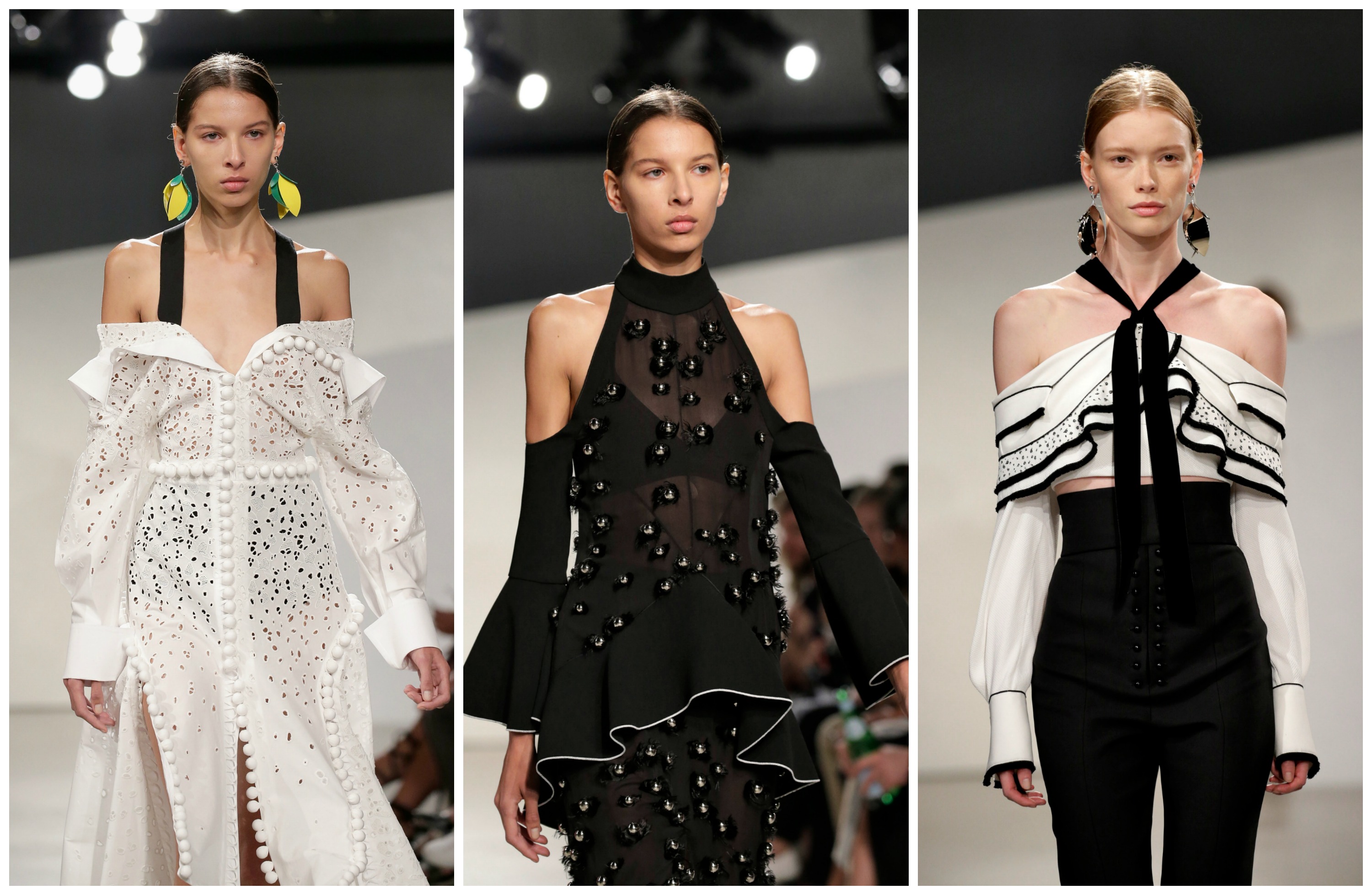Models aggressively stride across a stage in an unfinished building in Paris, against a backdrop of scaffolding and crumbling cement walls. As they confidently turn onto the runway, strong backlight and an atmospheric haze makes their genders difficult to distinguish. Silhouettes, instead, are drawn into stark contrast, with one feature in particular standing out—broad shoulders, catching the eye because of the rhinestones that trim them, the pads that raise and extend them, or the sleeves that exaggerate them.
Though aesthetically distinctive, luxury retailer Saint Laurent’s Fall/Winter 2017 Collection, shown on the runway this past February, dovetailed with a larger trend. Over the last two fashion seasons, shoulders, both padded and exposed, have pervaded the runways of high-end designers including Balenciaga (Spring 2017), Thierry Mugler (Fall 2017), and Gucci (Fall 2016). According to several fashion journalists, “power dressing”—a style that sartorially establishes women’s authority, often in the workplace—was back.

(Photo: Pascal Le Segretain/Getty Images)
The “power dressing” idea, of course, has long been associated with padded, powerful shoulders: Victorian women of the 1890s wore big sleeves, the New Woman of that decade perpetuated the trend, and professional women in the 1970s sporting suit jackets with formidable shoulder pads coined the term.
But this time, the “power shoulder” is coinciding with another shoulder silhouette that references a more restrictive era of dress for women. Off-the-shoulder styles have had their moments throughout fashion history, but were immensely popular for much of the early 19th century, before the first women’s liberation movement. When they popped up again on the 2015 runways of Proenza Schouler and Prabal Gurung and became one of summer 2016’s major trends, however, commentators heralded them for their body positivity; some even categorized them as a form of “power dressing.”
This evolving message is a bit paradoxical: When they were last in vogue in a major way, bare shoulders flaunted women’s domesticity, and a privilege that some had to not have to work. But the newly empowered bare shoulder is also a testament to the way luxury fashion is currently attempting to reconcile with its new reality. With plenty of retailers selling imitations of high-end styles mere weeks after they appear on the runway, it’s no surprise couture houses are reframing this old, restrictive style to keep up with a fashion cycle that is moving faster than ever before. In the process, they are sending a strong message: Traditionally feminine looks are equally as powerful as broad-shouldered, masculine ones.

Last year, in her attempt to explain the off-the-shoulder trend, stylist Karla Welch told New York magazine, “Historically, the slip of a shoulder always has been appealing.” Whether off-the-shoulders are timelessly attractive or not, a slip of the shoulder has historically been an indicator of feminine style, a framing that has roots in the early 19th century.
Regardless of season or time of day, fashion plates of the period show that the predominant silhouette for early Victorian women were bodices with a shoulder seam or neckline that fell over the top of the arm. As a result, the wearer’s range of motion was severely compromised. These styles literally kept women in their place—as mere ornaments for the households they maintained. “Women were guardians of the home, where they were to create a haven of peace and refuge for the head of the family from the coarsening world of capitalism outside,” Elizabeth Wilson and Lou Taylor describe in Through the Looking Glass: A History of Dress. A quiet household was perhaps an inevitable outcome of the fashion: These type of sleeves made it difficult for a woman to do more than sit and embroider or sip a cup of tea.

(Photo: Wikimedia Commons)
In the 1890s, fashion introduced a sartorial solution for women who had to (or merely wanted to) move: shoulders accentuated by bold sleeves. Fashions for all women between the years 1890 to 1896 saw a shift from the previous decade’s emphasis on styles below the waist, at the back of the figure—like large and prominent bustles—to an emphasis on the upper body. Enormous sleeves, the period’s major trend, seemed to grow larger with each passing year. These “leg-o-mutton” sleeves, as they were known, extended out and up from a sleeve that started at the natural shoulder point, which allowed for full range of motion.
Not every woman wearing leg-o-mutton sleeves was a feminist, but for those who did hold such views, a silhouette that intrinsically projected freedom worked in their favor. The “New Woman,” living on the brink of a turning century, saw a world of opportunities opening up to her. She took advantage of increased employment opportunities outside the home, fought for a voice politically in her push for suffrage, and demanded better access to higher education—as well as to more mobile sleeves. In July of 1889, The Lady, a popular periodical of the time, referred to the broader sleeves worn by the New Woman as “revolutionary.”
Shoulders have waxed and waned in popularity since the era of the New Woman, over a period of time that has seen women gain the right to vote, the invention of the Pill, and businesswomen become chief executive officers of major corporations. The high-end clothes of Yves Saint Laurent, particularly those in his Fall/Winter 1976 Russian Ballet and Opera Collection, where off-the-shoulder silhouettes co-existed with puffy, raised sleeves, translated the worldly, bohemian spirit of the 1970s into fashion. The traction that the Women’s movement was gaining at this time lurked on the periphery of couture, though, until the 1980s, when sleeves rose to the shoulder to become the most recognizable symbol of the working woman.

(Photo: Wikimedia Commons)
History would tell us that broad shoulders coincide with eras during which women are on the move, and restrictive, off-the-shoulder silhouettes with those that reinforce restricted roles. But particularly in today’s world of fashion, as demonstrated on the runway and analyzed in print, nothing is so cut and dry. Designers, with the aid of the fashion press, have worked diligently over the past few seasons to project that it is again the right time to draw attention to exposed shoulders. Melding the women’s empowerment messages of “power dressing” with the femininity rhetoric of the early Victorian era, many have argued that these styles are universally sexy and body-positive.
Last year Brooke Jaffe, the women’s ready-to-wear fashion director at Bloomingdale’s, emphasized to the Washington Post how flattering the silhouette is for all women, regardless of body type: “I don’t know many women who hate their shoulders,” Jaffe said.
Vogue went so far as to suggest that Hillary Clinton may have predicted the current off-the-shoulder trend in 1993, when she wore a Donna Karan dress with shoulder cutouts to that year’s State Dinner. In an interview with Lena Dunham that prompted the Vogue article, Clinton noted that Donna Karan, the designer of the 1993 dress, remarked, “No matter your age, your size, your shoulders always look good.”

(Photo: Alain Jocard/AFP/Getty Images)
Though several journalists have heralded the return of open shoulders, others have noted that the hassle of wearing these styles remains. Earlier this year, Jezebel writer Kara Brown argued that omnipresent off-the-shoulder and “cold shoulder” styles were “impractical and difficult to pull off” because they often require a strapless bra, and are difficult to put on with most jackets. (The title of the article: “I Hate These Goddamn Tops.”) Glamour magazine questioned how Dakota Johnson, who wore the style last year, could move in her top. For runway models who don’t have to do much more than walk down the catwalk, confining attire isn’t an issue. But translating this runway look into a normal person’s wardrobe can be frustrating—sleeves require constant re-adjustment after tasks as simple as reaching down and tying one’s shoes. And forget about keeping them in place while riding a bike.
Nevertheless, a search of H&M or Zara’s websites for “off-the-shoulder blouses” today yields dozens of results. Anthropologie has a dedicated category in its drop-down menu for them.
Ultimately, however, these silhouettes have not filtered into the general marketplace because they proclaim a message of the empowered woman, or because they relay an impression of a restricted one. Women who buy these styles are purchasing them for the reasons pointed out in glowing articles: They’re flirty, feminine, flattering on all body types, and, perhaps most importantly, they’re new.
Since the early 2000s, so-called “fast fashion“—referring to a group of retailers that produce goods imitating styles seen on runways and sell them at a much lower price point, weeks after they’ve debuted—has revolutionized luxury goods. These retailers, like H&M, Forever 21, and Zara, craft clothes with obsolescence in mind: By selling trends at low price points, they encourage consumers to seek instant fashion gratification in cheap, trendy clothing that is replaced each season. These retailers have accelerated fashion cycles at an ever-quickening pace, following suit when high-end designers inevitably turn to new trends for their next collection. For the time being, off-the-shoulder silhouettes have become the must-have item on the runway and at Zara—until the next new thing comes along.

(Photos: JP Yim/Getty Images)
But bare shoulders haven’t just re-emerged now because they’re a fresh new style for consumers to buy at the mall. Since the 1970s, designers have increasingly dressed the individual, not the masses. Ever since the emergence of counterculture groups like hippies, punks, and feminists, who broadcasted their political and social agendas through their clothing choices, the fashion world has drawn inspiration from individuals expressing movements, and their own fleeting feelings, through clothing. Four decades later, fashion has come to reflect women’s moods and whims as much as it telegraphs societal expectations about how they present and behave themselves.
Today, runways featuring both off-the-shoulder silhouettes and power shoulders don’t convey the hypocrisy of a fashion world that has forgotten its own history so much as a fashion world that is continuing its attempt to catch up to the present. By showcasing bared shoulders with covered ones, designers are seeking to appeal to a modern, multi-faceted woman who is comfortable conveying traditional messages of both power and femininity in their clothes. In the process, designers are embracing a semi-radical message: that those two categories aren’t necessarily distinct to begin with.




